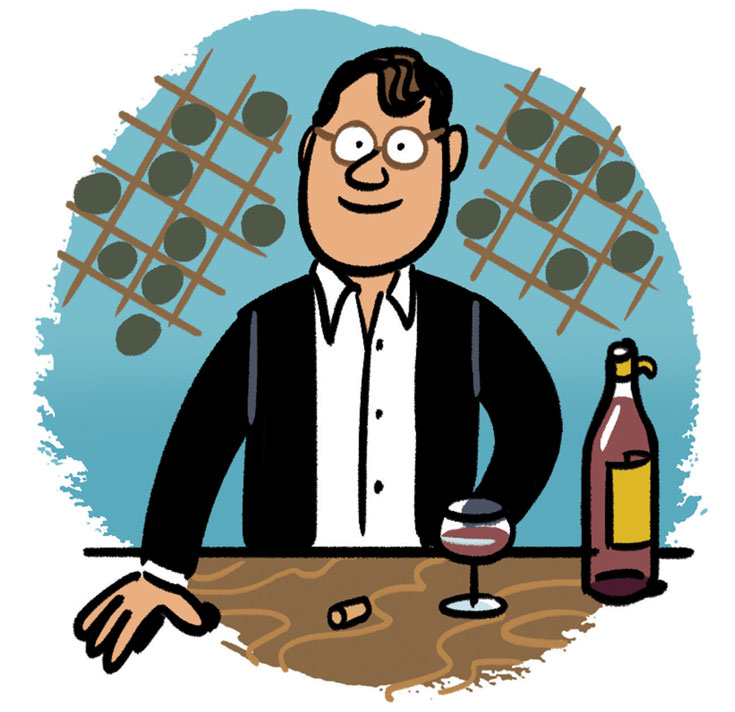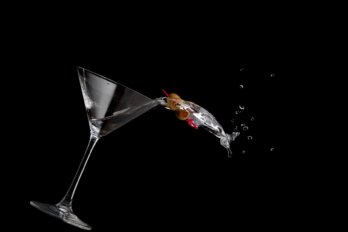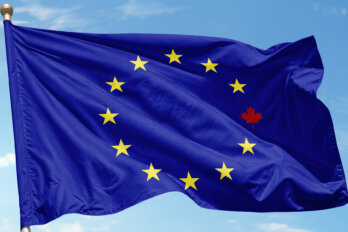Listen to an audio version of this story
For more audio from The Walrus, subscribe to AMI-audio podcasts on iTunes.
On a drizzly November evening, the Palais de la Bourse shines like gold, its Ionic pillars lit from below, its cupola poking through the mist. The palace, built at the centre of Bordeaux’s eighteenth-century riverfront and bearing a striking resemblance to Paris’s Place Vendôme, is an apt venue for a gathering of winemakers. When Jacques-Olivier Pesme strides into the banquet hall, his trench coat the same honey hue as the antique stone, he looks right at home.
He scans the room. “Let’s start with Mendoza.”
The wine-tasting party is a hot ticket at the Great Wine Capitals conference, an exclusive annual gathering of the world’s most powerful wine-producing regions. And on this, the twentieth anniversary of the Great Wine Capitals Global Network, Pesme, fifty-two, is a marquee name, headlining talks and generally holding court to more than 100 high-octane delegates who have flown in from five continents. Pesme’s expertise in tourism, brand identity, and global positioning has earned him a reputation as a sort of wine whisperer. It’s also led him to his current position as director of the University of British Columbia’s Wine Research Centre, where he has the unusual academic mandate of supporting the development of the province’s wine industry at home and abroad. The goal is that, one day, the Okanagan Valley will be as well-known as the Loire.
Pesme seems less egghead than rock star this evening—it takes us ten minutes to advance from the coat check to the ballroom’s threshold, so steady is the barrage of air kisses in his direction. I leave him to the crowd and escort myself around the room, sipping Spanish Riojas, Napa Cabernets, Bordeaux Supérieurs. Finally, I arrive at Argentina’s Mendoza.
“My friend told me I should have started here,” I say to the man holding the bottle.
“Who’s your friend?” he asks. I give Pesme’s name.
The man informs me that my friend is a genius. I chuckle politely. But he’s not joking: “Here he comes now.”
Pesme walks toward us with his million-euro smile, and the two of them hug.
The Argentine pours glasses of Malbec. Pesme swirls his around as he enthuses. “Wine is like music. Everyone has their own taste, even though you have to admit that Beethoven is objectively beautiful.”
He clarifies. Just as there are fantastic wines all over the planet, every region has a distinctiveness that endears it to people on an emotional level. Like a fragrance, a certain wine can remind you of a particular time or event or lover. Or it could simply be a stand-in for an aspiration—a geographical ideal. Pesme says that Mendoza wines—produced since Spanish colonization but only exported widely since the late 1990s—are a prime example of how this sort of intimate relationship can be forged quickly. He explains that the region’s success can be credited to the promotional body Wines of Argentina as much as to the wine itself. It comes down to the branding, the coherent message that each sip offers. When a person buys a Mendoza wine, no matter what winery is listed on the label, they are buying the immense landscape, the local cuisine, the character of its people, all bottled up together.
I look around the room at the ten international tasting bars, each with a toqued chef finessing foie gras and mini soufflés, and can’t help but question Pesme’s grand scheme for BC. Good marketing is one thing, but wine is a business synonymous with historical pageantry, stuffy hierarchies, and inscrutable assessments. Could a Canadian city really belong here, alongside Bilbao, Porto, and Bordeaux? Or are we destined to have oenophiles relegate us into the lower leagues, considered alongside Austria, Greece, and China?
Pesme, for one, is optimistic. “Canada is not ready . . . yet. But it has huge potential.” If anyone can help elevate the province, it’s him. He reckons that, if British Columbia takes a few right steps now, in a few years, it could become the new Mendoza.
Before her death, in 2014, Baroness Philippine Mathilde Camille de Rothschild, of the famous Château Mouton Rothschild vineyard, near Bordeaux, was once quoted in the Economist sharing the secret to her success. “Wine-making is really quite a simple business,” she said wryly. “Only the first 200 years are difficult.”
Bordeaux has more than 6,000 wine estates, with some vineyards dating back to the Romans. In Ontario—Canada’s biggest wine producer by acreage, volume, and revenue—wineries began to establish themselves about 150 years ago. BC wine emerged nearly seventy years after that. The west-coast province’s temperate climate, arid valleys, and fertile soils had proven conducive to grape growing, but according to the Washington Post, it wasn’t until the late 1980s that entrepreneurs with ample time and money migrated to the lands around Lake Okanagan en masse to take up viniculture.
In certain lights, BC’s business, some three decades on, seems robust. The province has more than 280 wineries, sales have risen more than twentyfold in as many years, and its vineyards welcome over a million visitors annually. Producers make more than 25 million litres each year, according to the BC Wine Institute—mostly European varieties like Pinot, Chardonnay, Merlot, and Cabernet. (Growers ripped out and replaced the region’s indigenous grapevines to better compete around the world.) Today, Okanagan’s Mission Hill is known internationally for its award-winning vqa Chardonnays; Nk’Mip Cellars, the first Indigenous-owned winery on the continent, has thrice been feted with the Chardonnay du Monde accolade. BC’s wine industry is now worth some $2.8 billion.
Yet the competition, too, has exploded. Pesme says that, in the 1980s, only about thirty-five countries could seriously call themselves wine producers. Today, about twice as many nations have skin in the game. Worldwide sales are expected to top $423 billion (US) by the end of 2023, according to Zion Market Research. Meanwhile, Canadians are still learning how to drink local: the country is estimated to be the world’s fifth largest wine importer, and according to the BC Wine Institute, the province still brings in about half the wine its population drinks. As for exports, only a small fraction of BC’s wine is sent abroad, mostly to China, Taiwan, and Japan.
Now consider its close-by competitor, California. The state earns more than twenty times BC’s wine revenue. Ditto the number of wine tourists, who amount to nearly 24 million annually. And Napa Valley wines have become synonymous with “American fine wine”—in 2018, they enjoyed a 61 percent market share not across the state but across the country. These are the sorts of numbers BC would need to pull in order to become a wine power.
The challenge of elevating BC’s wine business has become something of a cause célèbre for the University of British Columbia (UBC). When the university opened its Kelowna campus, in 2005, one area of focus was wine, and it soon developed courses that incorporated viticulture, wine sales, and marketing. UBC now has plans to expand its Wine Research Centre, currently based at its Vancouver campus, into the Okanagan, with Pesme acting as its new director.

When Roger Sugden came on-board as dean of the faculty of management, in 2012, he was tasked with supporting the development of the province’s wine industry. He thought the school’s research could help address some of the area’s hot-button issues: the wine sector was too fragmented, with inconsistent labelling and sustainability standards; it had no adequate plans for addressing climate change or competition from the burgeoning cannabis industry. Sugden had no background in wine himself, but a UBC colleague passed along the name of an expert that he ought to speak with: Jacques-Olivier Pesme.
Pesme, born in Bordeaux to doctor parents, had no relationship to wine in his youth other than drinking it with dinner— a common occurrence for Bordelais as young as eleven, he says. After university and a stint in Nantes exporting electronics, he returned home in the 1990s to start an economics PhD at the University of Bordeaux. Back then, he recalls, the word “sustainability” was starting to bounce around management circles, but only American schools were teaching business students how to address ecological and environmental concerns within their work. Pesme did a joint PhD program between Bordeaux, the University of Florida, and the University of the Virgin Islands. He came back to France a rare authority. When Kedge, France’s largest independent business school, launched a wine MBA, in 2000, the multilingual, sustainability-focused academic was hired, joining a small cohort of global scholars who focused on wine. He advanced to director and dean of the school’s wine program, all the while making gold-plated contacts when advising bodies like the World Trade Organization and the United Nations.
Unsurprisingly, Pesme had never heard of the Okanagan before he got UBC’s call in 2012. But he was ready for a change—for the “exoticism” of Canada’s west coast, for the challenge of helping the province become a worldwide player. He accepted a position as an affiliate professor (later becoming Sugden’s senior adviser), booked his first visit, and started learning “what it is to be a winemaker in BC and what it should be.”
The problem with British Columbia is not its wine—today, just about anyone is capable of producing the good stuff. Pesme has attended enough Pepsi-style blind taste tests to see plenty of old-world elitists mistake a new-world wine for their own. The challenge is to keep people wanting your stuff.
The regions that make up the Great Wine Capitals, that exclusive alliance of the world’s eleven preeminent producers, have spent years perfecting their images in order to woo drinkers and engender loyalty. BC is another matter. Few people outside the country know that Canada has a wine culture, let alone a British Columbian wine culture. Branding sells bottles, and though the province has good wineries, Pesme says, there isn’t a story that only BC is telling: “As a winery, you don’t exist if you’re alone.”
Unlike Verona or Porto, Kelowna doesn’t have the luxury of centuries to establish itself, not when it’s up against Cabernets from China, now considered the ninth-largest producer and growing quickly. That’s where Pesme comes in. His job is not to reward the best wines, help make bad wine better, or bolster production. The root of the wine business may be delicious wine, but a large part of what makes a region is how that wine is positioned, for locals and for tourists. It’s knowing the territory and appraisal of soil, that effusive mix of climate and culture that we call terroir.
Pesme makes a case for Adelaide, Australia—specifically McLaren Vale. In the past decade, the region has directed government funding to massive marketing campaigns that paint a unique proposition for day-tripping local drinkers: a sunny all-rounder with an abundance of beaches, farm-to-table restaurants, and scenic trails, all just forty-five minutes outside the city. That strategy works within Australia, where over 80 percent of the market for wine is domestic. Yet, when these wines show their faces to the world, McLaren Vale becomes “South Australia” to some, simply “Australia” to others. “Adelaide may compete domestically with regions like Margaret River, but as soon as they go abroad, they’re seen under one umbrella,” Pesme says. “They agree there is no success that’s not collective.”
Resolving that disconnect for BC is Pesme’s raison d’être. He’s so often on the move in the province—meeting with growers, establishing relationships between parties—that he’s never even rented an apartment in Canada. In 2017, he and Sugden went on a workshop tour from Duncan, on Vancouver Island, to Penticton, with the goal of challenging the industry to create a collective identity that BC wines could project internationally. Rendezvousing with industry players in six winemaking centres, they explored themes of authenticity, regional narrative, and terroir. They hashed out differences and commonalities, testing the merits of buzzwords like “pioneering” (rejected as too loaded) and “prestige.” After all the word clusters had been drawn and PowerPoints shown, Pesme extracted the characteristics they all seemed to share: “diversity,” “welcoming,” “free-spirit,” “cool North,” and “boutique.” That last descriptor is key. Pesme says BC wine has great potential if it sticks to the right script: positioning itself as a premium collective of boutique wineries and targeting the $20-to-$45-per-bottle price point.
In an effort to challenge vintners and spur growth, he and Sugden established the Wine Leaders Forum, an annual retreat where leaders from Canada and abroad form a collective strategy to make the province more competitive for the months ahead. Last year, the focus was tourism. This is where, in the Venn diagram of terroir and territory, the two overlap. “If you get it right, they should go hand in hand,” says Sugden. “How you present yourself to visitors is intimately tied up with how you present yourself at a table in Bordeaux or London or Melbourne. The way forward for tourism is coherent with the way forward for identity.”
Wine tourism is a new-world development widely agreed to have started in Napa Valley, California. Winemakers like Robert Mondavi put the area on the map in the 1960s and ’70s, a time when leisure travel and wine were both being democratized. Cellars were opened, offering visitors an unprecedented look behind the scenes, and chefs and musicians were invited to ply their trades on-site. The idea spread, and soon people began taking day trips into farmlands around the world—including Cape Town, Melbourne, and Seattle—exploring vineyards by bus or bicycle, or simply drunk-driving.
The phenomenon was soon everywhere—except in Bordeaux. “Until twenty years ago, you could not go to a winery or château in Bordeaux and buy wine,” says Catherine Leparmentier Dayot, who works for the Bordeaux Chamber of Commerce. “It would all go through wine merchants.” Back then, Leparmentier Dayot says, the French didn’t even have a phrase for “wine tourism.”
To catch up with shifting demands, Leparmentier Dayot launched the Great Wine Capitals Global Network (GWC) twenty-one years ago. She’d been watching the wine map evolve, identifying new competitors and seeing old ones mature. She recognized that Bordeaux was at risk of falling behind up-and-coming regions and that it would benefit from a symbiotic alliance of peers to create commercial exchanges, pool marketing resources, and network. “We were not promoting wine—wineries can promote wine—but best practices, innovation, tourism,” says Leparmentier Dayot, who is the GWC’s managing director. The collective was launched with cohorts in Porto, Portugal, and Bilbao, Spain, among others, gradually expanding to include new-world comers like Adelaide, Australia, and Valparaiso, Chile.
Prospective member cities must go through a strict recruiting process and should have a base population exceeding 250,000, an international airport, transport links, name recognition, and critical acclaim. The GWC considers one applicant per year, and some years it admits no one. In May, Cape Town and its surrounding winelands were invited to rejoin the GWC, bringing its numbers to eleven. “There aren’t many cities that meet our criteria,” Leparmentier Dayot says.
Today, wine tourists spend about 3 billion euros (approximately $4.6 billion) annually in Bordeaux’s province. That’s still shy of California’s $10 billion but strides ahead of BC’s $600 million. It was because of the GWC that Bordeaux realized, in the ever-shifting landscape of drinking habits, visitor experiences are now what make or break a region. In 2016, the city opened the Cité du Vin, an amorphous glass wine museum with a “global wine cellar” stocking bottles from Syria, Ethiopia, Namibia, Peru, Bali, and even BC’s Osoyoos Larose. It’s since welcomed more than 1.5 million visitors.
Across the border, Mainz, Germany, hosts the Mainzer Weinmarkt, an annual wine fair, in its quaint, old-timber city centre. And, in Portugal, Porto is set to open World of Wine, a museum complex stretching more than seven acres that boasts a collection of bars and restaurants as well as a wine school. The city, long famous for its port wines, is now facing local competition from nearby Vinho Verde. That region’s light, green wines, relatively new in Europe, are proving to be a hit, says Miguel Ribeiro, who runs Hotel Monverde, a “wine experience” hotel that features its own sprawling vineyard some seventy kilometres outside Porto. “It’s not easy to be disruptive in this business,” Ribeiro says. But, as Vinho Verde shows, it is possible.
If British Columbia is to earn a spot in the GWC, the Okanagan Valley—the heart of BC’s wine country—will likely need to evolve to become its main selling point. When Pesme first visited Kelowna, he found no heritage estate, no flagship museum, no boutique hotels, no statement architecture. There was no there there—the Okanagan seemed little more than a lonely outpost of vines. “BC wine is like drinking pure nature,” says Pesme. “In the southern part of BC, lakes have favoured a good cultivation of arable lands. There’s a sort of natural energy. First Nations understood that a long time ago. But you can’t take beauty for granted anymore. You need to understand your uniqueness beyond pristine nature.”
It also helps to know where visitors will be coming from. Linda Reiff, president and CEO of Napa Valley Vintners, says that, in her region, 80 percent of tourists are domestic. BC, a large province with a medium-size population in a very big country, can’t rely on the same localized strategy. Instead, it must consider following the lead of Portugal, where hotelier Ribeiro says that 60 percent of visitors are foreign. Luckily, BC does have a few hundred million Americans at hand—and, as Reiff notes, “Americans are consumers. When they visit, they buy.”
Still, tourism faces one significant challenge: with no effective public transportation from the provincial hub of Vancouver, the best way into the Okanagan for many visitors is a four-hour schlep by car. (Though big spenders can shell out $10,000 for the Sky Helicopter.) If BC can nail its unique selling proposition and work out how to shuttle visitors into the interior, more tourists will come knocking. “After the US, Canadians should be looking at Russia,” says Ribeiro. He describes it as an ideal match: BC’s food-friendly wines pair well with Russians’ predilection for vinegary dishes. “Portugal only has 1 percent of that market,” he estimates, “and Russia has a lot of people.”
Tastes are evolving, climates are changing, and the closely guarded conservatism of the wine world is all but gone. Two hundred years from now, just about any city could be on top. As Ribeiro says, “If you think Bordeaux has the best wine, we should all give up.”




